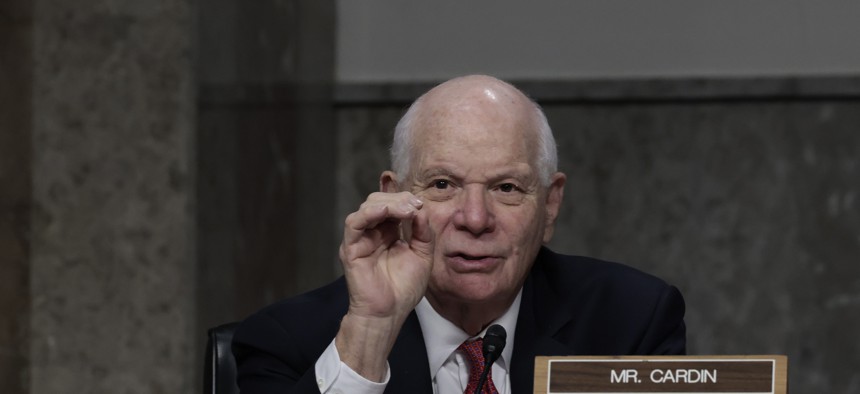The Infrastructure Law, One Year In

U.S. Senator Ben Cardin speaks during a hearing on Capitol Hill in 2021. Anna Moneymaker/ Getty Images
Local officials are still expressing appreciation for all the extra federal funding. But some, along with Republican lawmakers, are seeking tweaks on permitting and in other areas to make accessing and spending the money easier.
A year after President Biden signed the $1.2 trillion bipartisan infrastructure law, local transportation leaders say the funding will bring improvements to roads, sidewalks and bridges, as well as greater equity. But they also say that changes are needed to help with the rollout of all the new funding, including speeding up permitting for transportation projects and making it simpler for local governments to apply for the grants.
“This bill is a lot about jobs, creating good jobs here in America, modernizing our infrastructure,” Sen. Ben Cardin, a Maryland Democrat and chairman of the Environment and Public Works transportation and infrastructure subcommittee, said during a hearing on Tuesday, marking the anniversary of the law’s signing.
“With the passage of this bill, we advanced equity, and we advanced safety, and we met the challenge of climate change,'' Cardin said at the hearing.
The bill passed in a rare show of bipartisanship. “Turned out to be a good bill,” said Sen. Kevin Cramer of North Dakota, the top Republican on the subcommittee.
Still, Cramer and others said more needs to be done to improve the nation’s transportation infrastructure.
The law includes a provision called One Federal Decision, which requires federal agencies to coordinate their environmental reviews. The rule had been created by the Trump administration, then rejected by the Biden administration. But it was revived by the infrastructure law.
Cramer used the anniversary to call for greater permitting reform, an issue that has not been able to attract the same support in Congress across party lines.
“The clock is ticking, the calendar’s moving and inflation is real. We need to have some sort of permitting certainty and improved efficiency for infrastructure projects,” he said.
The one-step decision “is a step in the right direction,” said Jim Willox, chairman of the Converse County Commission in Wyoming, at the hearing. “However, obstacles still remain.”
Raising an issue that has especially divided Democrats and Republicans, Willox said requirements under the National Environmental Policy Act, one of the nation’s bedrock permitting laws, are “still cumbersome and counterproductive.”
The Biden administration requires federal agencies to consider the “indirect” and “cumulative” environmental effects of projects and not just the direct ones. That’s a reversal of changes made under Trump. Republicans are looking to undo Biden’s changes.
“There is little to no reason to go through the NEPA process to work on or replace a county road bridge that's been in place for decades,” Willox said. “The NEPA in this case only adds costs, delays and frustration to the real goal of implementing and improving our transportation system.”
Willox also criticized a “Buy America” mandate in the infrastructure law requiring iron, steel and other materials used for many infrastructure projects to be produced in the United States.
While Willox said he supports the idea in “concept,” he added that it should be applied in a flexible manner that takes into account factors like when materials aren’t available domestically, or when the costs are so high it’s detrimental to the public interest.
Willox also criticized standards the U.S. Department of Transportation set for states to receive a share of $5 billion to install electrical vehicle chargers along interstate highways.
The standards, in part, require charging stations to be within 50 miles of each other. “We don't have gas stations that are 50 miles apart in Wyoming,” he said. “There needs to be more flexibility, particularly in those rural areas where there isn't even a rest area for 70 miles on the interstate.”
Philadelphia, meanwhile, is enthusiastic about the funding for EV charging stations, according to Michael Carroll, deputy managing director of the city’s Office of Transportation and Infrastructure Systems. But even in a denser area than Wyoming, Carroll said he will be keeping an eye on federal requirements for where EV chargers must be located.
“We want to make sure that the spread is good, that people have equitable access and we have a little bit of discretion and flexibility,” he explained.
Overall though, local officials cited a wide range of benefits stemming from the law, including creating greater equity in transportation and alternatives to driving.
Carroll said Philadelphia has used funds from the federal Transportation Alternatives Program to improve walking safety around schools and to create higher quality bus stops and express transit service. ”People once stood in the dirt waiting to take a circuitous bus ride,” he said.
The infrastructure law will nearly double funding for the program from $850 million annually to around $1.4 billion a year from 2022 through 2026. “We will see more funding to extend this to other parts of Philadelphia and this will be one key to updating the entire bus network,” he said.
Another part of the law created a $1 billion pilot program to help reconnect often poor and minority communities that were divided by highways.
The new money could be used for a variety of purposes, including covering a highway, turning a highway into a boulevard, adding trails and bike lanes, installing sound barriers, and providing better connections to transit. The Biden administration’s Inflation Reduction Act added another $3 billion that can be tapped for these kinds of projects.
“In 1956, two U.S. highways were cut through our city and displaced residents,” Jacob Day, mayor of Salisbury, Maryland, told the committee.
“The bipartisan infrastructure law is a departure from the way things have always been done,” he said. “And that's a welcome change.”
Kery Murakami is a senior reporter for Route Fifty.
NEXT STORY: Why cloud is a budget breaker






